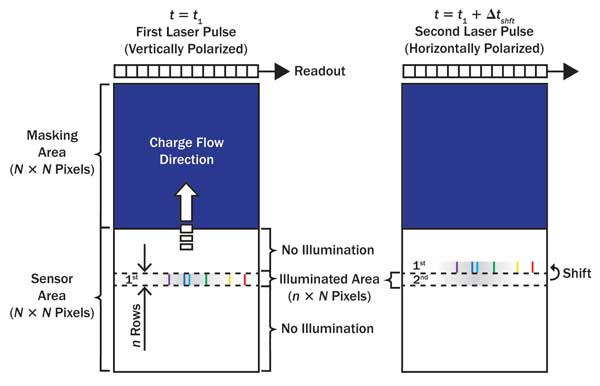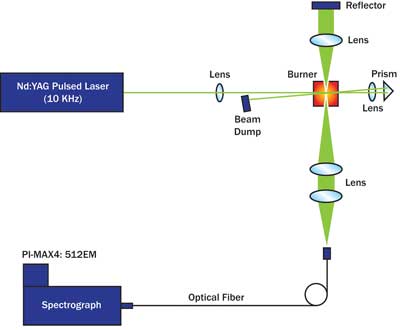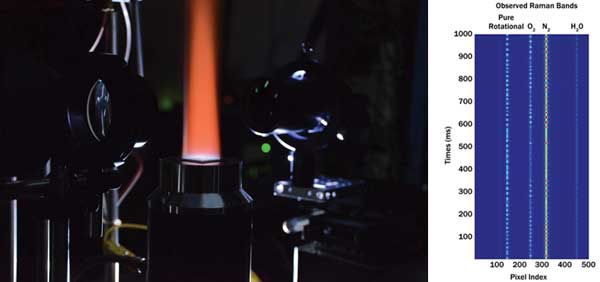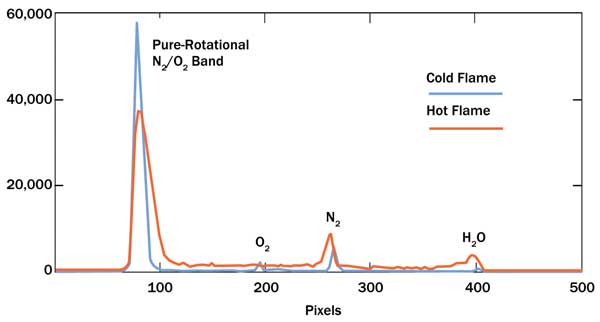Dr. Jun J. Kojima, Ohio Aerospace Institute, and Manjul Shah, Princeton Instruments Inc.
A new spontaneous Raman scattering spectroscopy technique uses an intensified EMCCD sensor to perform time-resolved combustion diagnostics.
To perform successful time-resolved spontaneous Raman scattering spectroscopy in combustion, one critical aspect1,2 is the implementation of a temporal optical gating scheme to reject optical background, thus increasing signal-to-noise ratio (SNR).
Until recently, only two temporal optical gating schemes were available to increase SNR: a mechanical shutter or electronic gating using an image intensifier. Many groups prefer the scheme in which an intensified CCD (ICCD) camera system is used because of its excellent fast-gating capability (subnanoseconds).3–6 Unfortunately, ICCD camera systems have several drawbacks, such as limited dynamic range as well as sensitivity that depends mostly on the photocathode quantum efficiency (QE).
The scheme, in which a fast mechanical shutter (with <10-µs gating capability)7–10 can be used to take advantage of the high QE of a back-illuminated CCD and to preserve wide dynamic range, also suffers from key drawbacks; e.g., gating at tens of microseconds reduces SNR because of the background introduced by laser-induced fluorescence. Furthermore, using a shutter often results in transmission losses of up to 50 percent due to internal relay optics and inherent timing jitter.
In 2010, Dr. Jun J. Kojima of the Ohio Aerospace Institute (a co-author of this article), working with Dr. David Fischer and Dr. Quang-Viet Nguyen of the NASA Glenn Research Center, described an architecture for SRS spectroscopy that uses a frame-transfer CCD sensor operating in a subframe burst-gating mode to realize time-resolved combustion diagnostics (Figure 1).11

Figure 1. Data-acquisition architecture in subframe burst-gating Raman spectroscopy. Photo courtesy of J. Kojima, Ohio Aerospace Institute/NASA.
Their patented technique12 enables all-electronic optical gating at <5-µs shutter speed without loss of optical throughput or image quality. The method uses a Princeton Instruments ProEM electron multiplying CCD (EMCCD) camera. Used with a pair of orthogonally polarized excitation lasers, the technique measures single-shot vibrational Raman scattering that is minimally contaminated by optical background noise.
While undoubtedly a significant step forward in time-resolved combustion research, this approach is not without limitations. Its relatively long gating, for instance, still leaves room for improvement of SNR in terms of rejection of background due to laser-induced fluorescence of C2 or polycyclic aromatic hydrocarbons.
Recently, the team advanced the technique further via the use of an innovative intensified EMCCD (emICCD) camera system that leverages the advantages of both EMCCDs and ICCDs by fiber optically coupling an EMCCD to an image intensifier. The new approach (Figure 2) offers even higher SNR and permits ultrahigh-speed observation of combustion dynamics.

Figure 2. Dr. Jun Kojima of the Ohio Aerospace Institute tests the new Raman spectroscopy technique at NASA Glenn Research Center. Photo courtesy of J. Kojima, OAI/NASA.
New method for time-resolved SRS
The researchers’ new experimental apparatus is shown in Figure 3. It measures Raman scattering with much faster gating than previously reported techniques (<200 ns) as well as wider dynamic range and higher sensitivity in combustion, allowing observation of flame instability dynamics via a newly introduced emICCD camera (Princeton Instruments’ PI-MAX4) that keeps up with the latest 10-kHz lasers.

Figure 3. Experimental apparatus showing a high-speed laser Raman diagnostic system employing
an Nd:YAG pulsed laser (532 nm, 88-ns pulse width, 10-kHz repetition rate) and a Princeton Instruments PI-MAX4: 512EM emICCD camera coupled to a lens spectrograph. Photo courtesy of J. Kojima, OAI/NASA.
In many practical propulsion applications, slow-speed, high-power pulsed lasers (10 Hz, >500 mJ per pulse) are prohibited as an excitation source because of the threat of optical window damage as well as the longer testing duration needed. It should also be noted that studying flame dynamics demands a sampling rate of at least an order of 1 kHz to resolve the thermoacoustic oscillation of combustion. The proposed high-speed diagnostics, enabled by a 10-kHz pulsed laser (20 mJ per pulse) and an emICCD camera (10-kHz gating), allow scientists and engineers to capture molecular signatures in combustion in a shorter period (e.g., 3000 shots can be accumulated in 0.3 s to record signal with higher SNR) and with better confidence in laser safety during operation.
Here, a second-harmonic Nd:YAG pulsed laser was used as an excitation source (200 W) and operated at a 10-kHz repetition rate to interrogate a flame. The scattering light was collected by fiber-coupled lens optics and transmitted to a volume-transmissive lens spectrograph equipped with the emICCD camera. To enhance the SNR, the image intensifier was operated at a 10-kHz rate to keep pace with the high-speed laser and gated at 90 ns to cut out the optical flame emission background, while the emICCD camera was operated at a rate of 1 kHz (i.e., 10 laser-shot accumulation) using a special feature within the software (Princeton Instruments’ LightField) that enables customization of CCD sensor size and readout speed. This custom detection setting effectively enabled the diagnostic system to reach the highest signal level ever achieved in the NASA facility without sacrificing the necessary kilohertz data rate.
High-speed laser spectroscopy measurements were performed using the diagnostic apparatus shown in Figure 3 at the Atmospheric Pressure Combustion Diagnostics lab, NASA Glenn Research Center in Cleveland. Figure 4a shows a close-up of a flame. Figure 4b presents data for temporal variation of spontaneous Raman scattering of combustion species (oxygen, nitrogen and water vapor) measured at the tip of a fuel-lean hydrogen-air flame. Pixel region 1-512 corresponds to the wavelength region of 486 to 680 nm.

Figure 4. (a) Close-up of flame. (b) Time-series Stokes Raman scattering spectra recorded at a sampling rate of 1 kHz over 1 s in an oscillating fuel-lean hydrogen-air flame using the high-speed Raman diagnostic apparatus. Photos courtesy of J. Kojima and D. Fischer, OAI/NASA.
The signal visibility in Figure 4b is significantly higher than previously reported data of this kind. The data clearly shows that the flame oscillates at a certain frequency (here, ~46 Hz) due to an interaction of the flame with ambient air entrainment. Careful observation reveals that the pure-rotational band is in inverse correlation with the O2 and N2 spectra. This is explained by the fact that the pure-rotational band is a flame marker (high temperature), in contrast to the two species, which decrease their peak intensity at higher temperature. A higher concentration of water vapor (H2O), the combustion product, appears when the flame is observed. It is significant that flame dynamics were characterized in a species-resolved fashion using high-speed Raman spectroscopy.
Data from another flame dynamics experiment is seen in Figure 5, which shows a comparison of two different Stokes-side Raman spectra measured in a fuel-lean (lower temperature) and a stoichiometric (higher temperature) hydrogen flame. Note
that both the pure-rotational and vibrational bands of the combustion species were successfully obtained. The unique temperature-sensitive feature of the pure-rotational band as well as the major species concentrations are clearly revealed in these measurements. Because of the wide dynamic range (16 bits) of the emICCD camera, the challenge of acquiring simultaneous measurements of the intense rotational band and the inherently weak vibrational band was overcome by gating out the background optical emissions via the high-speed intensifier gate.

Figure 5. Complete Stokes Raman spectra (3000-shot on-chip accumulation) measured in a hydrogen flame via the high-speed diagnostics. Photo courtesy of J. Kojima, OAI/NASA.
Key technology
New emICCD technology delivers a combination of precision, true single-photon detection, intelligence and speed. The back-illuminated EMCCD sensor used in emICCD camera systems boasts 95 percent QE at 532 nm, the wavelength typically used for SRS spectroscopy in combustion. Coupling the EMCCD to an image intensifier via fiber optics delivers 6× higher light throughput between the image intensifier and the detector than lens-coupled configurations. Fiber optic bonding also provides much better SNR than lens-coupled devices.
Furthermore, emICCD camera systems deliver significantly higher SNR than EMCCD camera systems that do not use an image intensifier. Table 1 shows the SNR attained with an emICCD camera versus that attained with a (nonintensified) EMCCD camera.
Table 1.
EMCCD versus emICCD SNR attained

The linearity and dynamic range of emICCD cameras, achieved by intelligently programming gains between the image intensifier and the EMCCD, are critical for quantitative imaging and spectroscopy applications such as combustion. Their true single-photon detection capability, meanwhile, ensures the high sensitivity needed for light-starved applications. An ability to acquire 10,000 spectra per second when operated in a special custom chip mode allows emICCD cameras to capture every pulse from next-generation lasers.
Future directions
The recent use of a new diagnostic apparatus to measure the dynamics of each individual molecular species, as opposed to simply acquiring bulk information (e.g., pressure), points to the possibility of performing temperature and frequency analyses of species in combustion. Ultimately, such potential applications could become diagnostic tools for fuel-air ratio dynamics at different temperatures and pressures.
Advances in scientific detector technology, such as the ability of emICCD cameras to gate out all optical background noise at <1 ns and thus improve SNR for time-resolved spontaneous Raman scattering spectroscopy in combustion, continue to extend the horizons of research. Other areas of exploration that might benefit from new detection strategies involving emICCD technology include fluorescence lifetime imaging microscopy studies, planar laser-induced fluorescence studies and quantum dots.
Meet the authors
Dr. Jun Kojima is principal scientist at the Ohio Aerospace Institute in Cleveland. Manjul Shah is an applications specialist at Princeton Instruments Inc. in Trenton, N.J.; email: [email protected].
References
1. R.S. Barlow (January 2007). Laser diagnostics and their interplay with computations to understand turbulent combustion. Proc Combust Inst, Vol. 31, pp. 49-75.
2. E.P. Hassel and S. Linow (2000). Laser diagnostics for studies of turbulent combustion. Meas Sci Tech, Vol. 11, R37.
3. J.H. Frank et al (December 2005). Multiscalar imaging in partially premixed jet flames with argon dilution. Combust Flame, Vol. 143, pp. 507-523.
4. D. Geyer et al (December 2005). Turbulent opposed-jet flames: A critical benchmark experiment for combustion LES. Combust Flame, Vol. 143, pp. 524-548.
5. L. Wehr et al (January 2007). Single-pulse 1D laser Raman scattering applied in a gas turbine model combustor at elevated pressure. Proc Combust Inst, Vol. 31, pp. 3099-3106.
6. M. Taschek et al (Nov. 1, 2005). Quantitative analysis of the near-wall mixture formation process in a passenger car direct-injection diesel engine by using linear Raman spectroscopy. Appl Opt, Vol. 44, pp. 6606-6615.
7. A.N. Karpetis et al (2004). Laser imaging system for determination of three-dimensional scalar gradients in turbulent flames. Opt Lett, Vol. 29, pp. 355-357.
8. R.S. Barlow et al (2009). Application of Raman/Rayleigh/LIF diagnostics in turbulent stratified flames. Proc Combust Inst, Vol. 32, pp. 945-953.
9. J. Kojima and Q.-V. Nguyen (December 2008). Observation of turbulent mixing in lean-direct-injection combustion at elevated pressure. AIAA J, Vol. 46, pp. 3116-3127.
10. Q.-V. Nguyen (Aug. 30, 2005). High-speed electromechanical shutter for imaging spectrographs. US Patent No. 6,937,331.
11. J. Kojima et al (2010). Subframe burst gating for Raman spectroscopy in combustion. Opt Lett, Vol. 35, pp. 1323-1325.
12. Q.-V. Nguyen et al (Nov. 13, 2012). Interference-free optical detection for Raman spectroscopy. US Patent No. 8,310,671.
About Raman spectroscopy
Raman spectroscopy is a nondestructive technique that enables the observation and study of solid, liquid and gaseous samples based on the inelastic scattering of monochromatic light (typically generated by a laser). This technique uses a photosensitive device such as a CCD to detect photons that have been absorbed by the sample and scattered at either a higher or lower frequency than the incident monochromatic light. These frequency shifts, known as Raman shifts, yield data about vibrational, rotational and other molecular modes.
Since the discovery of the Raman effect by Sir C.V. Raman and his colleague K.S. Krishnan in 1928, many variations of Raman spectroscopy have been developed and used extensively by researchers to enhance sensitivity, improve spatial resolution or acquire very specific types of information.
Distinct variations of the technique include SERS (surface-enhanced Raman spectroscopy), TERS (tip-enhanced Raman spectroscopy), resonance Raman spectroscopy, CARS (coherent anti-Stokes Raman spectroscopy), Raman microspectroscopy and SRS (spontaneous Raman scattering) spectroscopy, to name but a few.